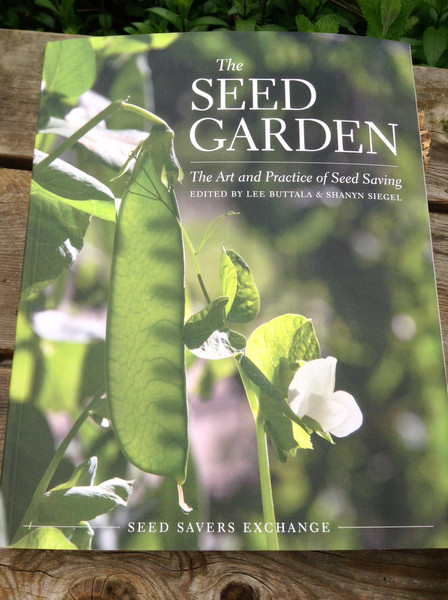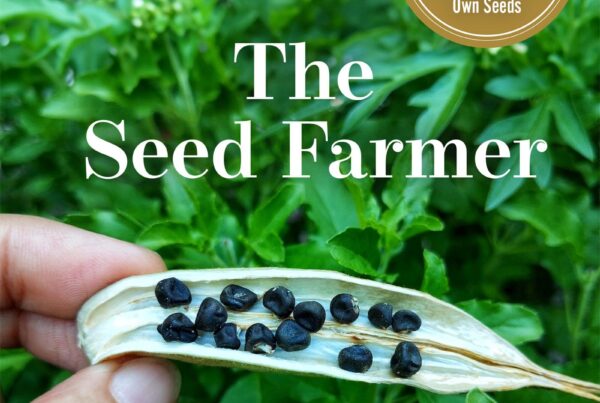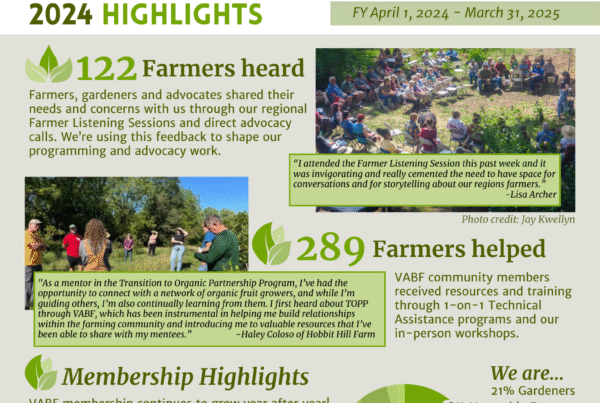The Seed Garden: The Art and Practice of Seed Saving
Edited by Lee Buttala and Sharyn Siegel. Written by Michaela Colley and Jared Zystro. Published by John Torgrimson, Seed Savers Exchange, 2015. Distributed by Chelsea Green $29.95 400 pages.
Seed Savers Exchange published Suzanne Ashworth’s Seed to Seed in 1991, one of the first popular seed-saving books. The Seed Garden brings the information up to date. This is a beautiful, inspiring and informative book, which provides all you need to know to start seed growing, or to start saving seeds from a crop new to you. The explanations are clear. The technical information that you need is in a very readable, accessible form. Many mysteries and confusions are cleared up. With this book, you have all you need to understand how to reliably get plentiful viable pure seed.
The Seed Garden is written for home gardeners as well as farmers, and is divided into two sections. First comes the Art and Practice of Seed Saving, then come the individual Crop Profiles
Section 1 covers the botany of seed saving, pollination methods, plant life cycles, maturity indicators, seed harvesting and drying methods, seed-borne diseases, seed longevity and how to store seeds.
Section 2 includes information on population size (how many plants you need to preserve genetic diversity), and isolation distances (how much distance is needed between your seed crop and other crops it could cross with). The crop profiles are by scientific name. Appendices explain germination testing and a table of seed-borne diseases.
Throughout the book are “Master Class” sections, giving two or three pages of practical advice (such as how to hand pollinate squash) and explanations of important phenomena such as inbreeding depression, photoperiodism and vernalization. There is an excellent glossary and a good index.
There are chapters with Regional Considerations. For example the mid-Atlantic has hot summers long enough for most heat-loving crops, such as cowpeas, limas, eggplant, peppers, sweet corn, melons and watermelon. There is regular rainfall and high humidity, which can lead to fungal and bacterial diseases, so it is harder to grow dry-seeded crops. Harvested material should be brought under cover. Biennial seed crops can usually be over-wintered outdoors. Except in the hotter regions of the mid-Atlantic, winter is cool enough for vernalization. Cool season crops are best sown early so that seed is produced before the very hot weather which can reduce seed quality.
I read up about growing buckwheat seed, because I participated in a VABF/VSU buckwheat trial which included growing some seed. Buckwheat takes 10 weeks to produce mature seed. Temperatures above 90F reduce seed yield. The minimum population size is 80 plants, and the isolation distance is 800ft-1/2 mile for home use, 1-2 miles for commercial seed. Buckwheat has perfect flowers (that is, all flowers have both male and female parts), which come in two types. The pin types have long styles and short stamens; the thrum type have short styles and long stamens. An individual plant produces only one type of flower and pollination is only possible between different flower types. This is referred to as an “obligate outcrosser”.
Another section I studied was the explanation of the difference between Brassica napus and Brassica oleraceae. Brassica napus varieties (rutabagas, Russian and Siberian kales) are biennial and must undergo vernalization in order to flower and set seed. Vernalization requires plants with about 8 leaves standing for 10-12 weeks at temperatures below 40F. They are hardy to 10F. Brassica oleraceae annuals (such as heading broccoli) on the other hand, have only a minimal cold requirement of 1-4 weeks below 50F before they start to flower. The biennial B oleraceae (European kales, Brussels sprouts, cabbage, collards, kohlrabi, sprouting broccoli) need 10-12 weeks below 50F before flowering. They are hardy to 20F or lower (some much lower).
Finally I read up on growing sweet potato slips, which I do every spring, hoping to learn a new trick. Presprout at 80-85F and 90% humidity, for 2-3 weeks. (I think I do that) Then plant in 2-3” moist sand at 80-85F for 4-5 weeks until shoots emerge. (Yes, I do that but use compost rather than sand.) Cut the slips 1” above the sand (compost) when they are 8-12” tall. (Yep.) Pot up or plant directly (We plant into flats for a few weeks). I’m on the right track, no worries there.
My examples show you the level of detail and breadth of topic that this book includes. Additionally, the photos are breath-taking. A book of practical inspiration!
On the Seed Savers Exchange page for the book, you can view a short video about seed-saving.
By Pam Dawling







